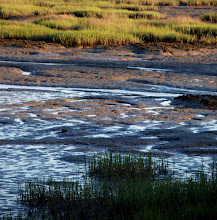

These are social events: wedding parties, family reunions, church dinners, fisherman’s feasts, yacht club annual occasions, or communal Rotary get-togethers. Everyone in the Lowcountry hosts oyster roasts, some with beer-marinated oysters, some with croaker sacks (wet burlap sacks) to lay on top of the steaming oysters. Most oyster roasts have Frogmore stew or Lowcountry boil on the side, or some sort of Cajun beans and rice and seafood, or barbecue, or almost certainly cole slaw, or hotdogs with chili. Probably all oyster roasts have a beer keg or beer van, wine in large plastic containers, and coffee and colas.
Conscientious oyster cooks use power washers to get the pluff mud off the local oysters. The oysters are often steamed in steam-tables that look like stainless barrels with moving parts; but sometimes they are just thrown on barbecue grates and the wet-down burlap sacks thrown on top.
The season for oyster roasts extends through the months with R in them, from September through March (though March gets a little hot to feel comfortable next to a steam table). High season includes December and January, and a very sociable family might hit three oyster roasts in two weeks, with any luck.
Around these parts, the tastiest little oysters are rumored to be those from Bluffton, especially those from the May River and the Bluffton Oyster Company (757-4010) owned by the Reeves family. The "oldest continuous oyster-shucking facility in South Carolina" is at 63 Wharf St. in Old Bluffton, and the secret of the tastiness of the Bluffton oyster is supposed to be in the precise degree of salinity of the May River water
that washes in and out of the beds. An oyster boat is still called a "bateau," but bateaux are now in competition with some models of the Carolina Skiff, commercial wide-bottomed boats with a shallow draft. Most of the bateaux that I saw lying around were wrecks.
that washes in and out of the beds. An oyster boat is still called a "bateau," but bateaux are now in competition with some models of the Carolina Skiff, commercial wide-bottomed boats with a shallow draft. Most of the bateaux that I saw lying around were wrecks.
The skipjack, a Chesapeake Bay oyster boat with two graceful sails, sadly stopped production (they were built by individual shipwrights) in the 1940s. A local craftsman in the Beaufort area whose work is of museum quality, Tom Boozer, will make an authentic miniature skipjack or a South Carolina-variety oyster boat for you for about $3500, putting in as much as 400 hours of labor to put the sticks together artfully.
At a large oyster roast, the oysters are dumped on broad tables, preferably tables set out under a nineteenth-century oyster factory’s roof, out of the wind on very cold nights. At the Rotary feast, you can see most of the old families from the region under one roof.
The Yankees, newcomers, and come-yahs distinguish themselves by doing all the wrong things. I have heard tales of people from barbarous and unknown regions in the U.S., like Indiana, paying the help to dump a larger share of oysters at their table. Those barbarians do not understand that a Lowcountry oyster roast is a laid-back social event where you meet people, where you don’t get too drunk, and where you don’t hog the oysters. And of course some people do not read the large new signs about not mingling paper trash or aluminum cans in the trash barrels where you dump the shells to be recycled. Nowadays the used oyster shells do not go into tabby walls or crushed shell driveways as much as they go back into oyster beds, to help seed the ocean with lime chunks for new oysters to build their shells with.
The Lowcountry’s revenge on the Yankees is not to tell them that an oyster shell has a sharper edge than most surgical steel carving knives. A lot of Yankee blood is shed at oyster roasts, while the Confederate locals all wear gloves (now orange, and washable) just meant to blunt an oyster’s sharpness. Some local folks actually wear mail fists, like medieval knights. And a Yankee might not know what an oyster knife looks like, whereas all the locals will bring their favorite old oyster knife with them, some of the knives worn down to a sliver by constant prying through the muscle attaching the top and bottom shell of oysters.
The etiquette for large-scale oyster roasts includes knowing when to leave for home. That will probably be when the Cajun, bluegrass, honkytonk band quits its second set, or right past the time when the well-dressed man with the giggling blonde wife says to you, a man, laughing, "Would you like to dance? I am considering giving up heterosexuality." You should park not too far from the entrance to the parking lot; you should not drink too many beers or glasses of wine if you are the designated driver; and you need to watch your feet, after eating so much you can no longer see your feet, when you step down from concrete into sand at the entrance of the oyster factory shed.
One note on croaker sacks, a.k.a. crocker sacks, gunny sacks, or burlap sacks: the name in Jamaica is "crocus sacks," and the sacks seem to have been used to collect the heads of crocuses–the flowers; Americans corrupted the spelling by not knowing how to match "crocus" with "sack."


No comments:
Post a Comment